Talk to a Registered Dietitian and use INSIDER20 for 20% off!
Talk to a real Dietitian for only $99: Schedule Now
This post contains links through which we may earn a small commission should you make a purchase from a brand. This in no way affects our ability to objectively critique the products and brands we review.
Evidence Based Research To fulfill our commitment to bringing our audience accurate and insightful content, our expert writers and medical reviewers rely on carefully curated research.
Read Our Editorial Policy
With dozens of numbers, percentages, grams, and milligrams, plus a laundry list of ingredients ranging from aspartame to xanthan gum, food labels can be downright confusing to look at.
While it can seem daunting at first, it can be highly empowering to understand food labels and use your knowledge to make healthier choices once you get the hang of it.
In this article, Registered Dietitian Cambria Glosz will take you through how to decipher everything on a food label, the top ingredients to watch out for, and more.
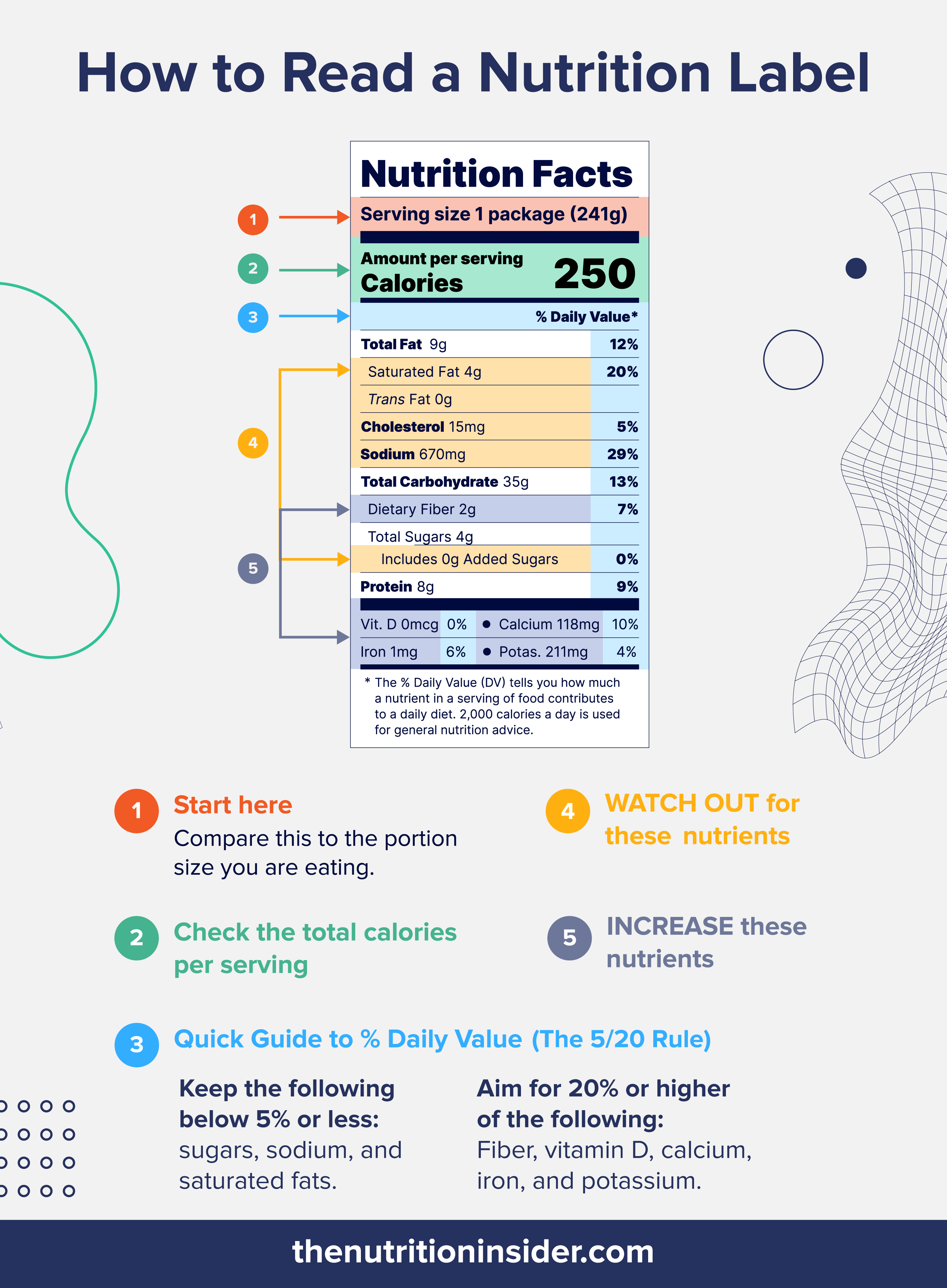
The panel on your food or beverage can give you a lot of nutrition information and help you follow a healthy diet, starting with serving size.
The serving size and serving per container are vital information on a food label. This is where many people are fooled by nutrition labels.
Although the FDA sets serving sizes, they don’t always reflect what people typically eat.
For example, you may quickly look at a bag of chips or cookies and see that there are only 140 calories…but that means per serving, and the serving size may be just six chips or one cookie.
Therefore, you need to assess how many servings you will eat before you know how many calories or nutrients are in something.
To stick with the chips example, let’s look at the label from Trader Joe’s tortilla chips. If you were to eat 12 chips (which is relatively easy to do in one sitting), you would multiply everything on the label by two because the serving size is six chips.
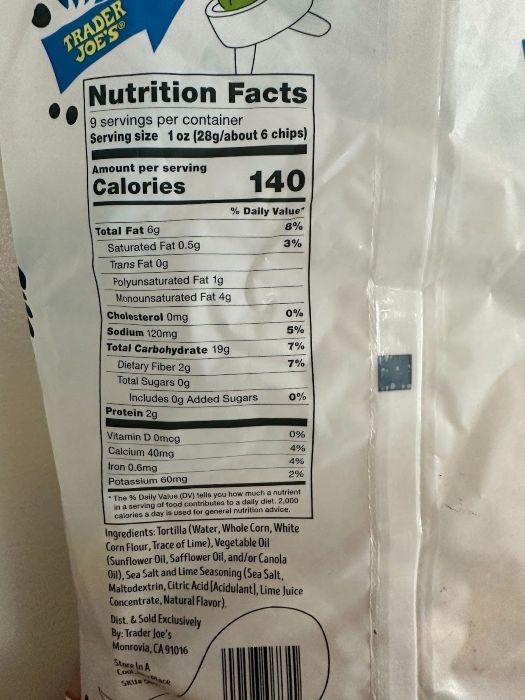
So, 12 chips from this bag would set you back:
In comparison, a serving size of the protein-packed chicken chips from Wilde is 20 chips, which is a reasonable amount someone would eat, providing:
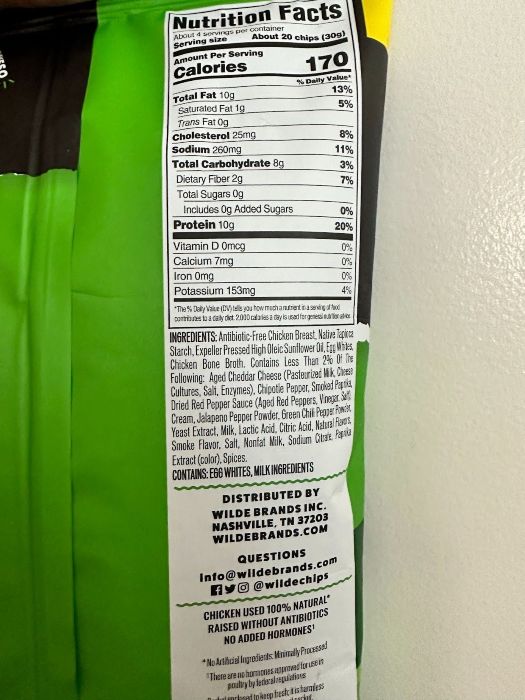
Sometimes, food manufacturers will help you out by doing the math for you, as seen in this example with pretzels. They (rightly) assume that you’ll eat more than three pretzels, so they also show the nutrition facts for the whole container. However, this is not required.
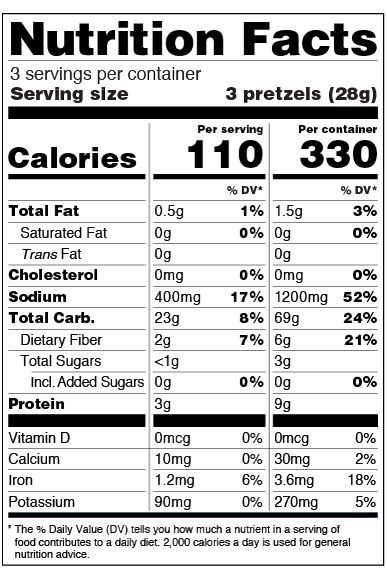
Almost everybody is familiar with the term “calorie,” but the definition and meaning behind “calories” is a bit more complicated.
Put simply, calories are energy. Every part of our bodies relies on input from calories to turn into energy our cells can use.
To maintain your weight, the calories you consume should be about the same as the amount your body uses, including for exercise, digesting food, and simply sitting and resting.
Everyone’s caloric needs are different, based on age, sex, height, weight, and physical activity level.
The FDA uses 2,000 calories a day as a general guide for nutrition advice, but you can calculate your caloric needs with a calculator like this one.
Based on your individual caloric needs, you can determine whether the calorie count in a meal or snack is suitable. For example, if you aim for 2,000 calories per day, you would not want a meal that is 1,000 calories, as that would be half of your daily allotment.
As of 2016, the FDA (Food and Drug Administration) created an updated Nutrition Facts label, including displaying calories in a larger and bolder font to make it easier to find.
The percent Daily Value shows how much of a macronutrient (carbs, fats, and proteins) or micronutrient (vitamins and minerals) in a serving of food contributes to what the average person needs in their diet.
Looking at the %DV can help you determine if the food or drink is low or high in a particular nutrient.
As a general guide:
However, the %DVs for the macronutrients are based on a 2,000-calorie diet, so it can vary widely individually. Conversely, the vitamin and mineral %DVs are not based on calorie intake.
Not all nutrients always have a Daily Value, including protein, trans fat, and total sugars.
Let’s look at an example, this time on a food label for frozen meat lasagna.
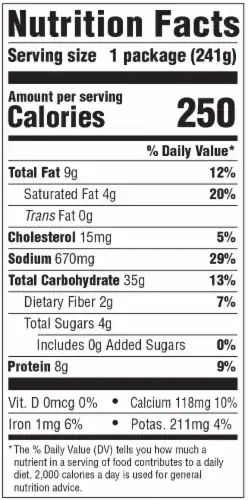
Assuming you ate the entire package, the %DV for saturated fat would be 20%, which is likely on par with your total daily consumption goals.
It also has 29% of your DV for sodium, which is definitely on the high side. You’ll also notice that the vitamin and mineral levels are low, with the highest one being calcium at 10% of your DV.
Overall, the Daily Value can be a tool to keep you on track for your nutrition goals. If you eat three meals per day, aiming to get one-third of your macronutrients from each meal can be a rough estimate (unless you are a snacker, then save room for those!).
We mentioned the macronutrients in the %DV section, but added sugars deserve a special call-out.
Another 2016 revision from the FDA was the addition of the added sugars line, which can help you determine which are naturally occurring sugars (like whole fruit or dairy) and which were added during processing.
Added sugars are those added during the processing of foods and include regular sugar (like cane sugar, table sugar, brown sugar, cane juice, and dozens of other types), sugars from syrups and honey, and sugars from concentrated fruit or vegetable juices.
Although honey, maple syrup, and 100% fruit and vegetable juices are naturally occurring, they are still considered added sugars per the FDA.
Some sugars get a free pass, so to speak. For example, if a food product uses dates or another whole fruit to sweeten the product, it does not have to be listed as an added sugar.
On food labels, the Daily Value for added sugars is 50 grams per day, which is based on a 2,000-calorie daily diet.
Four vitamins and minerals are required to be shown on a food label, but some food manufacturers include more.
As of 2016, the four required nutrients are vitamin D, calcium, iron, and potassium.
Vitamin D and potassium were recent additions, as it was determined that these nutrients were more likely to be insufficient in the American diet compared to vitamins A and C, the nutrients they replaced.
If you’re concerned about your intake of these vitamins and minerals, take a look at the amount listed (either in milligrams or micrograms) and the percent Daily Value shown.
Several items are required on every nutrition facts label, no matter if the product is fruit juice or frozen waffles:
Some food and beverage packaging manufacturers go above and beyond and include additional information on their nutrition facts labels.
Although all packaged foods and beverages must show the four vitamins and minerals—vitamin D, calcium, iron, and potassium—a food manufacturer may want to show that they also have good levels of other micronutrients in their product.
Similarly, some fat-forward foods (like olive oil or nut butter) might show how many grams of monounsaturated fat is in their product rather than just saturated fat and trans fat.
Not all food products in the grocery store have nutrition facts labels. For example, a bunch of bananas or a pile of potatoes will not have a food label slapped on it unless the produce is pre-cut or in a bag or container.
You may have memories of meat or poultry not having food labels, but since 2012, a nutrition facts label has been required on most commonly used meat products. All ground meat and poultry products and 40 of the most popular cuts of meat and poultry (the “major cuts,” which include sirloin steak, pork chops, and chicken thighs, to name a few) must also have a nutrition facts label either directly on the label or on a prominent store display or brochure with the product.
Although all components of a food label are important to look at, some primary areas to focus on when you’re analyzing its health status include:
Contrary to popular belief, the cholesterol content in food is not so important. Research in recent years has concluded that dietary cholesterol (found only in animal products) does not significantly affect blood cholesterol. Therefore, a food label that shows it’s high in cholesterol—like eggs, which have about 60% of the DV for cholesterol per egg—does not mean it’s unhealthy.
You’ll also want to take a look at the ingredients list. Although the general rule of thumb is that a long list of ingredients is unhealthy, there can be exceptions to the rule. For example, a product containing many components or dozens of herbs, spices, and seasonings can look unhealthy, but, in actuality, it is just fine.
Let’s take a closer look at some ingredients to watch out for on a food label.
While we don’t like labeling things “good” or “bad,” the truth is that some food ingredients simply are unhealthy and unwise to consume regularly.
Although you will never make or break your health with one meal—unless you’re severely allergic or it’s poisoned, that is—healthy eating comes down to what we do most of the time for most of our meals.
That said, some specific food ingredients that are not so great to consume include:
One ingredient you’ll want to avoid at all costs is trans fats. Although trans fats were banned in 2018 and are no longer generally recognized as safe (GRAS), some lingering food products that have escaped detection may still use them. Look for the phrase “partially hydrogenated oil” and do not consume that product, as trans fats are undeniably linked to heart disease.
You may wonder why trans fats are still on the nutrition facts label if they have been banned. This is because the FDA ruling does not affect naturally occurring trans fats, which are healthy types found naturally in meat and dairy from cows and goats.
The percentages on a food label are the percent Daily Value, which shows how much of a macronutrient (carbs, fats, and proteins) or micronutrient (vitamins and minerals) in a serving of food contributes to what the average person needs in their diet.
Looking at the %DV can help you determine if the food or drink is low or high in a particular nutrient. The Daily Values are reference amounts of nutrients to consume or not exceed daily.
As a general guide, 5% DV or less of a nutrient per serving is considered low, and 20% DV or more per serving is considered high.
Single-ingredient, non-packaged foods—like fresh, whole, non-bagged fruits and vegetables—do not need a nutrition facts label. In the past, not all meat and poultry were required to, either, but the rules changed in 2012. Now, all ground meat and poultry and most packaged and commonly purchased cuts of meat and poultry (the “major cuts”) require a nutrition label.
The 5-20 Rule is based on the %Daily Value shown on nutrition labels. It means that if the %DV listed is 5% or lower, then it is low in that nutrient. If the %DV is 20% or more, then it is high in that nutrient.
Some ingredients to avoid include:
• Trans fats (partially hydrogenated oils)
• Artificial sweeteners (aspartame, sucralose, saccharin, acesulfame-K)
• Artificial preservatives (BHA, BHT, TBHQ)
• Artificial food dyes (Red 40, Yellow 5, etc.)
• Potassium bromate (commonly added to bread products)
• Brominated vegetable oil (found in some citrus-containing juices or sodas)
• Growth hormones in meat or dairy (rBGH and rBST)
• Azodicarbonamide (a bleaching agent in dough)
It depends on what your health goals are. At a minimum, the average consumer should always look at the serving size and number of servings per container (don’t let a label fool you with serving size!), calories per serving, and added sugars. If you’re concerned with weight loss or maintaining a healthy body weight, you may want to look closely at the calories per serving. If you want to gain muscle, look at the protein content.